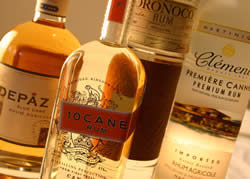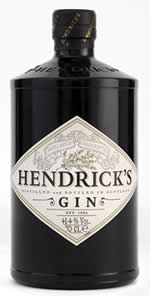Difference between Rum and Gin
Key Difference: Rums are distilled alcoholic beverages made from sugarcane byproducts such as molasses or sugarcane juices. Similar to most alcoholic beverages, rums must go through the process of distillation, fermentation and aging. Gin is a sprit that is derived predominantly from juniper berries. It is the flavoring of other spirits with extracts of juniper berries to give it a certain taste. The spirit is made using any fermented grain mesh such as barley, rye or any other grains.
Rum and gin are two different types of alcoholic beverages that are available for consumption. All the alcoholic beverages go through a similar process of fermentation and distillation; however they differ in taste, flavor and content. The difference between the alcohols arises from the different types of ingredients that are used to make the mash, the different flavors that are added to the alcohol and the aging process. Similarly, rum and gin are made using different ingredients and differ in taste and aroma.
 Rums are distilled alcoholic beverages made from sugarcane byproducts such as molasses or sugarcane juices. Similar to most alcoholic beverages, rums must go through the process of distillation, fermentation and aging. Depending on the geographical region of the product, rums differ in taste, color and strength. The origin of the term ‘rum’ is unclear and there are various different possibilities as to how the name came by. British etymologist, Samuel Morewood in his 1824 essay stated that the word ‘rum’ was a British slang term from “the best”. Morewood also suggested another possibility that the word was taken from the last syllable of the Latin word, “saccharum”, meaning “sugar”. Other possibilities include the word being derived from other popular British drinks of the time such as ramboozle and rumfustian.
Rums are distilled alcoholic beverages made from sugarcane byproducts such as molasses or sugarcane juices. Similar to most alcoholic beverages, rums must go through the process of distillation, fermentation and aging. Depending on the geographical region of the product, rums differ in taste, color and strength. The origin of the term ‘rum’ is unclear and there are various different possibilities as to how the name came by. British etymologist, Samuel Morewood in his 1824 essay stated that the word ‘rum’ was a British slang term from “the best”. Morewood also suggested another possibility that the word was taken from the last syllable of the Latin word, “saccharum”, meaning “sugar”. Other possibilities include the word being derived from other popular British drinks of the time such as ramboozle and rumfustian.
Majority of the rum in the world is produced in the Caribbean and Latin America, with selected other countries such as India, Spain, New Zealand, Mexico, etc. also partaking in producing the beverage. Rum was first distilled on a sugarcane plantation in the Caribbean during the 17th century. The slaves at the plantation discovered that molasses, a byproduct of sugarcane when it is refined into suger, could be fermented into alcohol. Other places to record early rum distillation include Brazil and Barbados. After the development of rum, it grew fast in demand and it was also used in many places as currency. To support the increasing demand of sugar, labor was required to work the sugar plantations. This resulted in the establishment of the triangular trade between Africa, the Caribbean and the European colonies. Rum also became popular with seamen and pirates.
Rum does not have any set production methods, with the methods varying depending on the region where the distillers are located. Similar to some other alcoholic beverages, rum goes through the process of fermentation of either molasses or sugarcane juice. During fermentation, the water and yeast is added to the base ingredient, allowing the yeast to break down the sugar. Depending on the type of yeast used for fermentation, the taste and aroma of the rum varies. After distillation, the rum is then put through the process of distillation. After distillation, the rum is required to be aged for at least one year in many countries. The aging process could be done in wooden casks (natural or charred) as well as in stainless steel tanks. The rum in the wooden casks is darker in appearance, while the rum in stainless steel tanks remains colorless. Caramel can also be added to rum to adjust the color of the final product before it is bottled.
According to Wikipedia, rum comes in certain grades and variations. They can be classified under the following:
- Light rums: Light rums are rums that are light or clear in color. They can also be referred to as white rum. They have very little flavor and are used in cocktails.
- Gold rums: Gold rums are also known as amber rums. They are often aged in charred white oak barrels. They have a stronger flavor compared to light rums.
- Dark rums: These are darker in color such as black, red or brown. They are aged for a longer period of time in heavily charred barrels. They may also have a hint of spices and caramel to adjust the color and flavoring. They are stronger and sweeter compared to the light and gold rums.
- Spiced rums: These rums obtain the flavor from spices or caramel. They are dark in color and may have spices such as cinnamon, rosemary, absinthe/aniseed, or pepper.
- Flavored rums: These rums are infused with additional flavors such as banana, coconut, citrus, etc.
- Overproof rums: These rums are higher in proof and ABV.
- Premium rums: These rums are high priced and are carefully aged and produced. They are said to have more flavor and taste.
 Gin is a sprit that is derived predominantly from juniper berries. It is the flavoring of other spirits with extracts of juniper berries to give it a certain taste. The spirit is made using any fermented grain mesh such as barley, rye or any other grains. Originally, gin was consumed as medicine before evolving to its current alcoholic status. The main flavor of gin is the juniper berries; however the flavor of the berries varies depending on different places. The history of gin dates back to the 11th century, where monks were known to flavor crude distilled drinks with juniper berries and it was also unsuccessfully used as remedy for the black plague. However, the Dutch physician Franciscus Sylvius is credited for inventing gin. The term gin is derived from either the French ‘genièvre’ or the Dutch ‘jenever’, both of which mean “juniper.” In short, gin can be known as flavored vodka.
Gin is a sprit that is derived predominantly from juniper berries. It is the flavoring of other spirits with extracts of juniper berries to give it a certain taste. The spirit is made using any fermented grain mesh such as barley, rye or any other grains. Originally, gin was consumed as medicine before evolving to its current alcoholic status. The main flavor of gin is the juniper berries; however the flavor of the berries varies depending on different places. The history of gin dates back to the 11th century, where monks were known to flavor crude distilled drinks with juniper berries and it was also unsuccessfully used as remedy for the black plague. However, the Dutch physician Franciscus Sylvius is credited for inventing gin. The term gin is derived from either the French ‘genièvre’ or the Dutch ‘jenever’, both of which mean “juniper.” In short, gin can be known as flavored vodka.
There are four different types of gin:
- Juniper-Flavored Spirit Drinks: These are the earliest class of gins, which are produced by pot distilling fermented grain mash. They are approximately 68% ABV in strength and are then redistilled with aromatic compounds.
- Gin: These are also juniper flavored, however they are not distilled with juniper or aromatic compounds, but the juniper flavor is added later on. It must have the predominant flavor of juniper in order to be sold as gin.
- Distilled gin: Distilled gin is made by exclusively redistilling ethyl alcohol of agricultural origin and has an initial strength of 95% ABV. It is also added with additional juniper berries and other natural botanicals.
- London gin: Wikipedia describes London gin as, “London gin is obtained exclusively from ethyl alcohol of agricultural origin with a maximum methanol content of 5 grams per hectoliter of 100% ABV equivalent, whose flavor is introduced exclusively through the re-distillation in traditional stills of ethyl alcohol in the presence of all the natural plant materials used, the resultant distillate of which is at least 70% ABV. London gin may not contain added sweetening exceeding 0.1 gram of sugars per liter of the final product, nor colorants, nor any added ingredients other than water. The term London gin may be supplemented by the term ‘dry’.”
Rum and gin differ in taste and aroma as rum has a sweeter taste compared to gin. Gin can be simplified as flavored vodka; however, the flavor must be of juniper berries. Gin tastes more like a spirit, while rum has a more sugary taste. Gin was predominantly used as medicine, while rum was discovered solely by accident on a sugarcane plantation. While rum is made using molasses, gin is made from fermented grains.
Image Courtesy: thekitchn.com, ginreviews.com









Add new comment